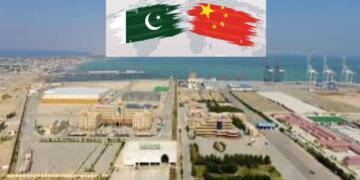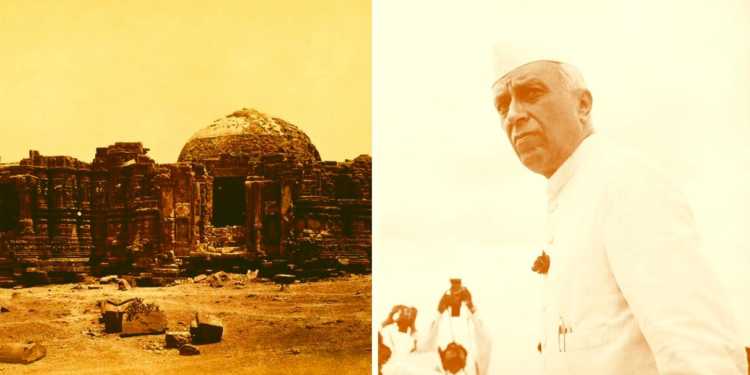Somnath Temple at Prabhas Patan near Veraval in Saurashtra is a place which stands today as a symbol of victory of Dharma, a temple that promulgates the fact that no matter how hard the evil forces strike, Dharma will emerge victorious. The temple has risen after being desecrated, burnt and battered and the political dynasty opposed to the idea of its reconstruction has its scion visiting the same temple. THIS IS KARMA.
Somnath temple is also a symbol of Hindu resurgence and victory, a pointer to the fact that irrespective of the number of attempts to destroy or even obstruct its repair, the temple has stood as a beacon of faith for Hindus for over 1100 years and will continue to do so. A fact, at the root of Hindu philosophy that states – the power of creation is greater than the power of destruction. The temple has been rebuilt over the years by Raja Bhoja, Mahipala Deva, Hindu rulers of Gujarat, temple built adjacent to edifice by Ahilya Bai Holkar and lastly by Acharya KM Munshi. The first destruction of the temple was done by Junaid Ibn Al Murri and the first obstruction to the reconstruction was done by “Pandit” Nehru.
In 1947, Nawab of Junagadh acceded to Pakistan but was re-assimilated to India by Sardar Patel himself, not undermining the leadership of Samaldas Gandhi against the Nawab who spearheaded the revolt of the people of Junagadh which ultimately led to the Nawab fleeing to Pakistan. Sardar Patel received a warm welcome when he visited the state of Junagadh accompanied by Sh. NV Gadgil and Jam Saheb. Jam Saheb mentioned in his memoirs“We then went down the steps to the sea. Sardar then took some water from the sea in his hands. He said to me “My ambition has been fulfilled”. We returned in silence and entered the temple. All his worries were gone now, and a new light was reflected on Sardar’s face.”
Sardar Patel then gave a rousing speech there to the people of Junagadh when he said “this government has come to fulfil and not to destroy. The age of reconstruction is now.” It is then when Sardar Patel Ji and KM Munshi Ji expressed their desire to renovate, objections came from expected quarters i.e. “secular” Nehru, “Appeaser” Gandhi and a section of Muslims.
Sardar Patel in a later visit said “The Hindu sentiment in regard to the temple is both strong and widespread. In the present conditions it is unlikely that the sentiment will be satisfied by the restoration of temple or prolonging its life. The restoration of idol would be a point of honour”
Role of Nehru in reconstruction of the divine Somnath Temple: A lesson for Indians
1. Objection to the idea of reconstruction: Nehru had a series of meetings with Gandhi in an attempt to block the reconstruction of the Somnath temple, a place sacred to Hindus. While, they could not object openly considering the sentiment of the public, they suggested that it is the state funding that would offend the secular character. However, the government was ready to spend money from its budget to repair and renovate the mosques damaged or destroyed in Delhi in the aftermath of independence. State help was also given to Sanchi and other Buddhist religious places in form of land grants.
After this suggestion and meetings with Gandhi, it was decided that Somnath Temple would be constructed with the help of daan by the people of India. The plan was set into motion and a trust was formed with the earliest contributions by Jam Saheb and within no time enough money was collected for the reconstruction of the temple.
2. “Hindu revivalism”: the path to reconstruction of the temple was fraught with obstructions time and again, this time it was fate. With the assassination of Gandhi and the untimely demise of Sardar Patel Ji, the responsibility of reconstruction fell in the able hands of Acharya KM Munshi. Nehru continued to express his displeasure to the reconstruction of Somnath temple and said to Acharya Munshi Ji “I do not like your trying to restore Somnath. It is Hindu revivalism”. The objection of Nehru came as a churlish surprise to Munshi and he left the room aghast and angry. He then penned the very famous letter to Nehru which was lauded by one and all as a true masterpiece.
Excerpt:
It is my faith in our past which has given me the strength to work in the present and to look forward to our future. I cannot value freedom if it deprives us of Bhagvad Gita or uproots millions from the faith with which they look upon our temples and there by destroys our lives. That makes me feel- makes me sure- that this shrine once restored to a place of importance in our life will give to our people a purer conception of religion and a more vivid consciousness of our strength, so vital in these days of freedom and its trials.
Upon reading this letter, Sh. VP Menon had commented that “I have seen your masterpiece. I for one would be prepared to live and if necessary die by the views you have expressed in your letter.”
3. Trying to stave off the visit of Sh. Rajendra Prasad Ji to attend the opening of the sacred Somnath temple: Rajendra Ji being true to his Dharma paid no heed to Nehru’s opposition. One may wonder whether this was why no memorial was built for him in Delhi. Another interesting fact is that Rajendra Ji’s speech at the time of installation of deity was published in all the newspapers except the official channels and All India Radio under strict orders from JL Nehru.
The translation of the speech is “Even as the creator of the universe, Brahma, resides in the navel of Lord Vishnu, similarly in the heart of man resides the creative urge and faith and all these surpass in power all the power, all the armaments, all the armies and all the emperors of the world. In the era, India had been a treasure house of gold and silver… centuries ago, the major portion of gold of the world was in temples of India. It’s my view that the reconstruction of the Somnath Temple will be complete on that day when not only a magnificent edifice will arise on this foundation, but also the measure of India’s prosperity will be really that prosperity of which the ancient Temple of Somnath was a symbol of.”
While the sycophant horde of Marxist historians would like you to believe that Nehru was in fact secular and owing to the secular nature of state was trying to prevent Rajendra Ji from attending the Somnath Temple opening. You must know that it is a sham. Nehru in fact helped to restore relics of stupa at Sanchi and attended the function of restoring relics in a mile long procession amidst chanting of hymns. He then handed the relics to chief Bhikshu, offered incense and flowers. This is in fact true Nehruvian secularism or simply put: minority appeasement.
Acharya KM Munshi in his book “Jai Somnath” mentions:
“In its name time and again, politicians in power adopt a strange attitude which, while it condones the susceptibilities, religious and social, of the minority communities, is too ready to brand similar susceptibilities in the majority community as communalistic and reactionary. How secularism sometimes becomes allergic to Hinduism will be apparent from certain episodes relating to the reconstruction of Somnath Temple.”
In the present scenario with the visit of Rahul Gandhi to Somnath and Congress’s exaggerated and desperate explanations after Rahul’s name was found in the non-Hindu register do hint at a divine justice.
Like I said in the beginning – It may take months, years even generations but ultimately Dharma prevails.
Jai Somnath!































